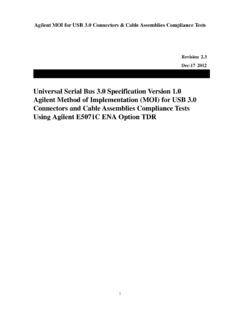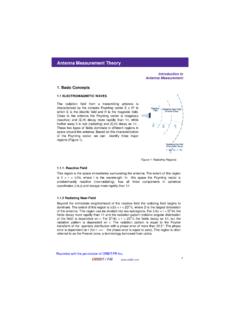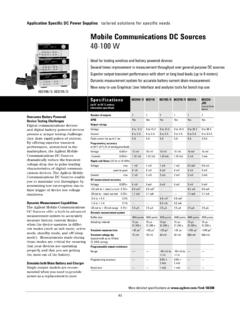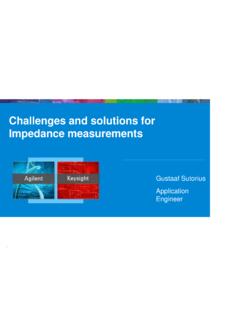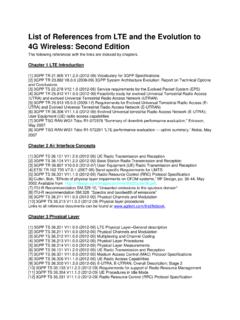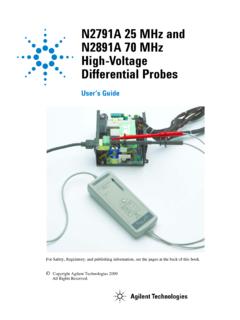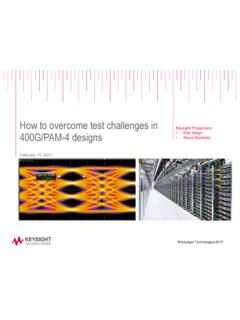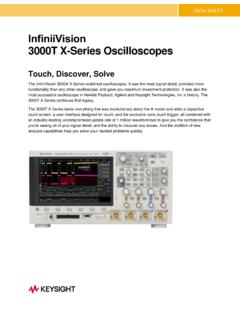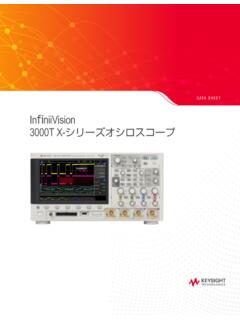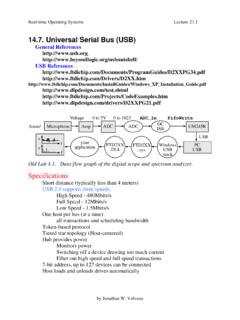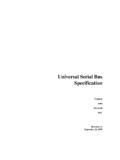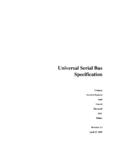Transcription of Universal Serial Bus 3.1 Specification Revision ... - …
1 Keysight MOI for USB Connectors & Cable Assemblies Compliance Tests 1 Revision Feb-06, 2015 Universal Serial Bus Specification Revision Keysight Method of Implementation (MOI) for USB Connectors and Cables Assemblies Compliance Tests Using Keysight E5071C ENA Option TDR Note: The final USB Connectors and Cable Assemblies Compliance Document ( Revision ) is not yet released. Test coverage and requirements are based on an early draft test Specification and will be updated when the final test Specification is complete. Keysight MOI for USB Connectors & Cable Assemblies Compliance Tests 2 Table of Contents 1. Revision History .. 4 2. Purpose.
2 4 3. References .. 4 4. Required Equipment .. 4 5. Test Procedure .. 5 Outline of Test Procedure .. 5 Setup .. 7 Recalling a State File .. 7 Saving a State File .. 8 Calibration .. 9 ECal Calibration and De-embedding .. 9 TRL Calibration .. 12 Adjustment of Effective Rise Time .. 14 Measurement .. 18 D+/D- Pair Propagation Delay Skew .. 18 D+/D- Pair Propagation Delay .. 19 Differential Crosstalk between D+/D- and SuperSpeed Gen 2 Signal Pairs .. 20 D+/D- Pair Attenuation .. 21 Channel Metrics (eH, eW, ILfitatNq, IMR and IXT) .. 22 Differential to Common-Mode Conversion .. 22 Cable Shielding Effectiveness .. 23 [Raw Cable] Characteristic Impedance (Informative).
3 24 [Raw Cable] Intra-Pair Skew (Informative) .. 24 [Raw Cable] Differential Insertion Loss (Informative) .. 24 [Mated Connector] Impedance (Informative).. 25 [Mated Cable Assembly] Differential Insertion Loss (Informative) .. 25 [Mated Cable Assembly] Differential Near-end Crosstalk (NEXT) between SuperSpeed Gen 2 Signal Pairs (Informative) .. 26 [Mated Cable Assembly] Differential Near-end and Far-end Crosstalk (NEXT and FEXT) between D+/D- Pair and SuperSpeed Gen 2 Signal Pairs (Informative) .. 26 6. [Appendix] Manual Setup .. 27 Channel & Trace Setup .. 27 D+/D- Pair Propagation Delay Skew .. 28 Parameter Setup .. 28 Crosstalk Compensation.
4 29 D+/D- Pair Propagation Delay .. 30 Differential Crosstalk between D+/D- and SuperSpeed Gen 2 Signal Pairs .. 30 Keysight MOI for USB Connectors & Cable Assemblies Compliance Tests 3 [Raw Cable] Characteristic Impedance (Informative).. 30 [Mated Connector] Impedance (Informative).. 31 Common Parameters Setup for Frequency-domain Measurements .. 31 D+/D- Pair Attenuation .. 32 Differential to Common-mode Conversion .. 32 Cable Shielding Effectiveness .. 32 [Raw Cable] Differential Insertion Loss (Informative) .. 32 [Mated Cable Assembly] Differential Insertion Loss (Informative) .. 32 [Mated Cable Assembly] Differential Near-end Crosstalk (NEXT) between SuperSpeed Gen 2 Signal Pairs (Informative).
5 33 [Mated Cable Assembly] Differential Near-end and Far-end Crosstalk (NEXT and FEXT) between D+/D- Pair and SuperSpeed Gen 2 Signal Pairs (Informative).. 33 Defining Limit Line Tables .. 33 7. [Appendix] Defining TRL Calibration Kit .. 34 8. [Appendix] De-embedding File Creation using PLTS AFR .. 39 2x Thru Standard Measurement .. 39 De-embedding File Creation .. 39 Keysight MOI for USB Connectors & Cable Assemblies Compliance Tests 4 1. Revision History Revision Comments Issue Date Draft Revision . Feb. 06, 2015 2. Purpose This test procedure was written to explain how to use the Keysight ENA Option TDR to make the connectors and cable assemblies measurements required per USB Specification Revision and Connectors and Cable Assemblies Compliance Document Draft.
6 3. References Universal Serial Bus Specification Revision (July 26, 2013) Universal Serial Bus Connectors and Cable Assemblies Compliance Document Draft 4. Required Equipment Description Test Equipment QTY Network Analyzer Keysight E5071C ENA Series Network Analyzer Option 4D5 (14 GHz) or 4K5 (20 GHz) Option TDR (Enhanced time domain analysis) 1 ea. 4-port ECal Keysight N4433A (4-port, 20 GHz) 1 ea. Test Fixture USB official test fixtures and calibration standards 1 ea. Adapter 83059B coaxial adapter for E5071C ports 4 ea. RF cable mm or SMA cables of 14 GHz bandwidth or more 4 ea. 50 ohm Terminator Termination for unused differential pairs (ex.)
7 Keysight 909D-301) 12 ea. Note: (20 GHz) is recommended as Type-C cable/connector requires measurements up to 15 GHz. Note: Fixtures for testing USB connectors and cable assemblies are available for purchase through Luxshare-ICT. Keysight MOI for USB Connectors & Cable Assemblies Compliance Tests 5 5. Test Procedure Outline of Test Procedure 1. Setup Automatic setup by recalling a state file or manual setup 2. Calibration ECal Calibration and De-embedding TRL Calibration Adjustment of Effective Rise Time 3. Measurements 4-1. Time-domain Measurements - D+/D- Pair Propagation Delay - D+/D- Pair Propagation Delay Skew - Differential Crosstalk between D+/D- and SuperSpeed Gen 2 Signal Pairs - [Raw Cable] Characteristic Impedance (Informative) - [Raw Cable] Intra-Pair Skew (Informative) - [Mated Connector] Impedance (Informative) 4-2.
8 Frequency-domain Measurements - D+/D- Pair Attenuation - Channel Metrics (eH, eW, ILfitatNq, IMR and IXT) - Differential to Common-mode Conversion - Cable Shielding Effectiveness - [Raw Cable] Differential Insertion Loss (Informative) - [Mated Cable Assembly] Differential Insertion Loss (Informative) - [Mated Cable Assembly] Differential Near-end Crosstalk (NEXT) between SuperSpeed Gen 2 Signal Pairs (Informative) - [Mated Cable Assembly] Differential Near-end and Far-end Crosstalk (NEXT and FEXT) between D+/D- Pair and SuperSpeed Gen 2 Signal Pairs (Informative) Keysight MOI for USB Connectors & Cable Assemblies Compliance Tests 6 Normative & Informative Measurement Parameters Note: Hard keys (Keys on the E5071C s front panel) are displayed in Blue color and Bold.
9 (Example: Avg, Analysis) Note: Soft keys (Keys on the E5071C s screen) are displayed in Bold. (Example: S11, Real, Transform) Note: Buttons of the TDR software are displayed in Green color and Bold. (Example: Trace, Rise Time) Note: Tabs of the TDR software are displayed in Brown color and Bold. (Example: Setup, Trace Control) Keysight MOI for USB Connectors & Cable Assemblies Compliance Tests 7 Setup Recalling a State File This section describes how to recall a state file of the E5071C that includes all the measurement settings for connectors and cable assemblies compliance tests. The state file can be downloaded at: Copy the state file into the E5071C s directory via USB mass storage device and recall the state file using the TDR software.
10 Necessary parameters for testing are automatically set up in the E5071C. Refer to Appendix for the details about manual setup. If TDR setup wizard is shown, click Close button in the TDR setup wizard main window. 1. Open Setup tab. 2. Click Advanced Mode to show the dialog box. 3. A dialog box appears requesting for confirmation. Then click Yes. (Uncheck Use Advanced Calibration Methods ) 4. Click File and select Recall State. 5. Specify a folder and a file name, and click Open. The E5071C s channel 1 is used for time-domain measurements by using the TDR software displayed at the bottom of the E5071C s screen. The channel 2 is used for frequency-domain measurements by using the hard keys on the front panel and the soft keys on the right side of the screen.
